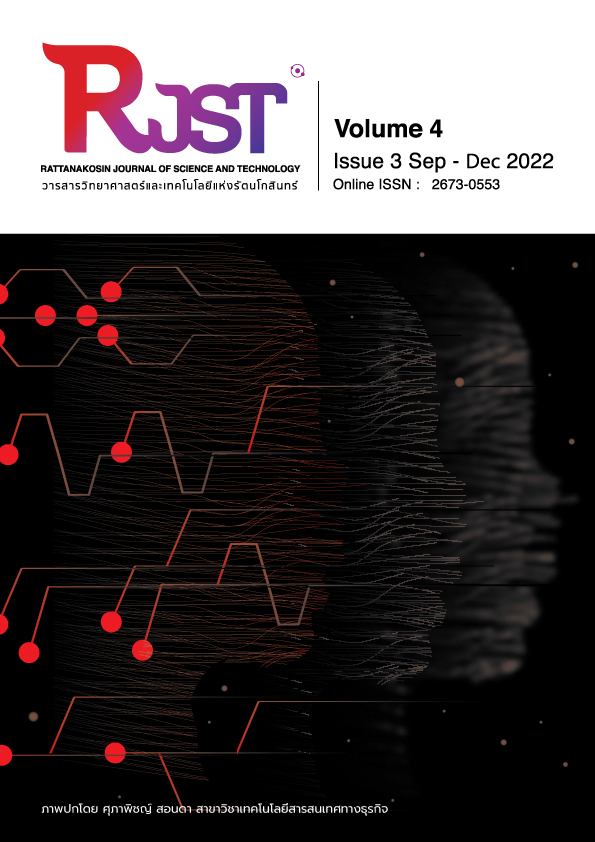Comparison of the classification efficiencies of K-means and Hierarchical clustering methods for candlestick component length on the world gold price candlestick chart
Main Article Content
Abstract
In this study, the classification efficiencies of K-means and Hierarchical clustering methods for candlestick component length on the world gold price candlestick chart were compared with the objective to reduce the ambiguity in the identification of candlestick size. The data used in this study consisted of the opening price, closing price, highest trading price and lowest trading price from the daily gold price in the world market of the United States during January 2, 2012 to April 30, 2021 for a total of 2386 days. The data was divided into 2 groups: training data and testing data. The experiment consisted of the calculation of length, ratio, mean and standard deviation and standardization. The data was then classified using K-means and hierarchical clustering methods which it was found that K-means clustering method resulted in 5 clusters, while hierarchical clustering method resulted in 3 clusters. The classification efficiencies for each component of candlestick chart based on CCI values in both training data and testing data were all higher than 70 for both clustering methods. This indicated that the classification was quite effective. However, K-means clustering method was more effective compared to hierarchical clustering method for gold price data in the world market.
Article Details

This work is licensed under a Creative Commons Attribution-NonCommercial-NoDerivatives 4.0 International License.
The content within the published articles, including images and tables, is copyrighted by Rajamangala University of Technology Rattanakosin. Any use of the article's content, text, ideas, images, or tables for commercial purposes in various formats requires permission from the journal's editorial board.
Rajamangala University of Technology Rattanakosin permits the use and dissemination of article files under the condition that proper attribution to the journal is provided and the content is not used for commercial purposes.
The opinions and views expressed in the articles are solely those of the respective authors and are not associated with Rajamangala University of Technology Rattanakosin or other faculty members in the university. The authors bear full responsibility for the content of their articles, including any errors, and are responsible for the content and editorial review. The editorial board is not responsible for the content or views expressed in the articles.
References
Chen S., Bao S., Zhou Y. (2016). The predictive power of Japanese candlestick charting in Chinese stock market. Physica A: Statistical Mechanics and Its Applications, 457, 148-165.
Dubey A. K., Gupta U. and Jain S. (2018). Comparative Study of K-means and Fuzzy C-means Algorithms on The Breast Cancer Data Int. J. Adv. Sci. Eng. Inf. Technol. 8 18-29
Fahim A. M., Salem A. M., Torkey F. A. and Ramadan M. A. (2006). An efficient enhanced k-means clustering algorithm, Journal of Zhejiang University Science A., pp. 1626–1633, 2006
Farley, A. (2015, September 22). The 5 Most Powerful Candlestick Patterns. Retrieved April 3, 2018, from https://www.investopedia.com/articles/active-trading/092315/ 5-most-powerful-candlestick-patterns.asp
Gradojevic, N., & Gençay, R. (2011). Financial Applications of Nonextensive Entropy [Applications Corner]. IEEE Signal Processing Magazine, 28(5), 116–141. https://doi.org/10.1109/MSP.2011.941843
Leon, C.-H., WenSung, L., & Liu, C. A. (2005). Candlestick Tutor: an intelligent tool for investment knowledge learning and sharing. Fifth IEEE International Conference on Advanced Learning Technologies (ICALT’05) (p. 238–240).
Muntaner C, Chung H, Benach J, et al. (2012). Hierarchical cluster analysis of labour market regulations and population health: a taxonomy of low- and middle-income countries. BMC Public Health.
Rousseeuw, P. J. (1987). Silhouettes: A graphical aid to the interpretation and validation of cluster analysis. Journal of Computational and Applied Mathematics, 20, 53–65.
R.A. Johnson and D.W Wichern. (2018). Applied Multivariate Statistical Analysis.
Sangsawad S. (2018). Candlestick Length Feature Clustering using K-Means Approach for Price Directions Analysis Case Study: SETHD index
Sudhir Singh, Dr. Nasib Singh. (2013). Gill, Comparative Study of Different Data Mining Techniques: A Review, www.ijltemas.in, Volume II, Issue IV, APRIL 2013 IJLTEMAS ISSN 2278 – 2540.


